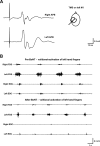Treating Congenital Mirror Movements with Botulinum Toxin
- PMID: 30713984
- PMCID: PMC6353364
- DOI: 10.1002/mdc3.12543
Treating Congenital Mirror Movements with Botulinum Toxin
Keywords: botulinum toxin; mirror movements; synkinesis; treatment.
Figures

References
-
- Woods BT, Teuber HL. Mirror movements after childhood hemiparesis. Neurology 1978;28:1152–1157. - PubMed
Publication types
LinkOut - more resources
Full Text Sources

